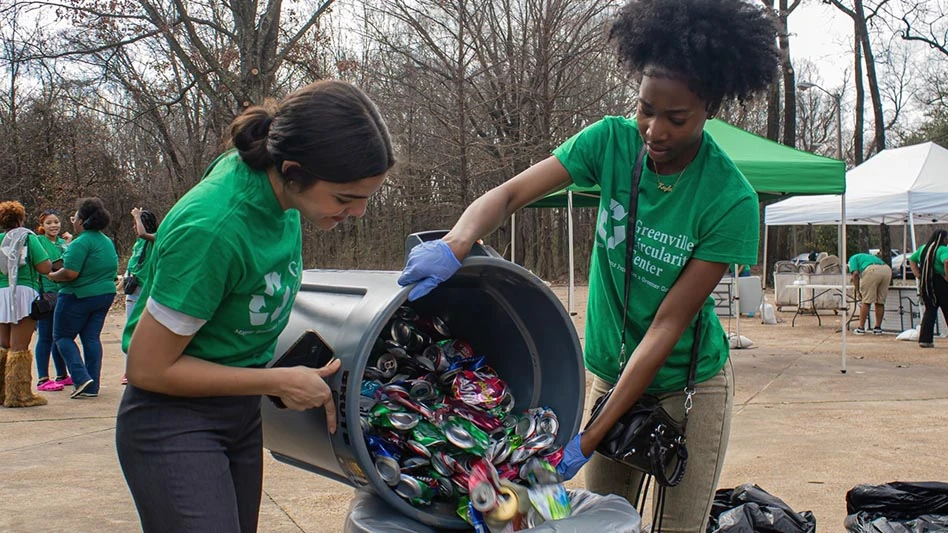Are you currently experiencing a reduction in shredder component life? It may be a result of a different mix of metals that you are processing today than you had in the past.
All shredder owners are looking to improve their profitability and performance. This comparison of manganese and alloy steels examines the differences in the steels to see which choice is the best for your shredder operation.
MANGANESE STEEL FACTS
Many car shredder hammermills use manganese steel for hammers and other components because of the severe impact they encounter. Manganese parts are usually castings, and, as cast, manganese is relatively soft (240 Brinnel [BHN] or 22.8 Rockwell "C" [Rc]). For comparison, some mild steels are 137 BHN or 9 Rc.
Manganese steel typically contains 10 percent to 14 percent manganese and 1 percent to 1.4 percent carbon. These two elements are used for increasing the strength and hardness of the steel. Some foundries are producing castings with up to 24 percent manganese for specific applications. To oversimplify, a higher percentage of manganese usually means longer wear life where significant impact conditions are present.
Impact is essential for manganese steel to become harder and more wear resistant. Without impact to harden the surface, it will wear away rapidly. When subjected to impact, high-stress scraping, gouging or pounding abuses, manganese can last significantly longer than white cast iron or non-alloyed high-carbon steel.
Impact on shredder components such as hammers and grates increases both the surface hardness and the strength of the manganese. Surface hardness of 1/8 inches to 3/16 inches deep may reach 550 BHN—54.7 Rc—or more. While the center of the manganese component remains ductile and is able to handle the shock of impact, the depth of the part’s hardness is dependent on the degree of stress from the impact.
Some people in the recycling industry believe it is the heat generated through impact that makes manganese hard, which is not the case. Heat does not make manganese harder; in fact, temperatures as low as 275 degrees Celsius/525 degrees Fahrenheit can be detrimental depending on the percentage of manganese and carbon in the wear part. High heat causes carbide precipitation in the steel grain boundaries, which causes brittleness.
Thermal conductivity of manganese is only 15 percent that of mild steel, so it retains much more heat. Because manganese steel doesn’t transfer heat easily, the thermal expansion is 1.5 times more than mild carbon steel. This is why shredders are designed to allow the grates to grow in size when they heat up during operation.
When some nonferrous or fine materials are processed, abrasion becomes the primary cause of wear. In this environment, the wear resistance of manganese is not much better than mild steel. Excessive abrasion will continually wear away the surface of the manganese, as the wear part does not have an opportunity to work harden. It is common to have manganese coal crushing hammers, which typically last six to nine months, wear out in three weeks when power plants change to softer coal with a significant amount of fine particles.
Use care when welding manganese steel to itself and particularly when welding it to carbon steel, as the shrinking stresses of welding can cause significant problems. This is because of the weld metal dilution with mild steel, which then contains much lower amounts of manganese and, as a result, may become brittle. Welding deposits without proper electrodes may end up between 1 percent and 2 percent manganese in the diluted zone, which tends to be brittle and prone to cracking.
ALLOY STEEL FACTS
While manganese steel gets its hardness through impact, alloy steels get their hardness from a specific combination of alloys. The most common elements used for increasing hardness are chromium, nickel and molybdenum. Vanadium, tungsten or boron may be added in amounts less than 1 percent depending on the application.
Alloy steels can be made into castings, plate, bar, etc., and are then heat treated, which will deliver a product that may register 477 to 512 BHN. This provides excellent resistance to abrasive wear with very good impact properties. It also has the same hardness throughout the component, unlike manganese, which only has a thin hardened layer that occurs from the stress of impact.
Chromium provides extreme hardness and wear resistance without becoming brittle, increases toughness and refines the grain structure of wear parts. Chromium is usually used with other alloying elements, such as nickel, molybdenum, vanadium or tungsten, and provides the greatest hardening effect of any element after carbon.
Nickel increases through-hardening capabilities, strength and toughness while reducing the effects of shock and corrosion.
Molybdenum produces the greatest deep-hardening effect while reducing the grain size. This creates tough, strong steels.
Carbon in alloy steels is seldom above 0.5 percent, whereas the amount of carbon used in manganese steel is more than 1 percent. In the world of metallurgy, that is a huge difference. Consider that in a 100-pound piece of steel, adding just 3 ounces (0.19 percent) of carbon can increase the hardness by 30 BHN, or 2.5 Rc.
Producers of low-cost alloy steel often increase the amount of carbon in their products for a high hardness reading, but the steel frequently becomes brittle and can be very difficult to weld.
COMPARING COMPOSITION
Chromium, nickel and molybdenum are significantly more expensive than manganese or carbon. Obviously, with more expensive chemistry and additional heat-treating requirements, the cost will increase. Historically, the difference in the cost of alloy steel components is nearly 20 percent greater than a similar manganese product from the same manufacturer.
A greater percentage of alloys usually translates into longer life, whether you are comparing hammers, hammer pins, grates or side liners. If you see every element on a wear parts supplier’s chart listed as "max," get your guard up. When you see "chromium, 2 percent max," your first assumption may be that you are getting steel that is 2 percent chromium. Be aware that it may contain only 0.4 percent or less, and the data will still be accurate since it is less than the 2 percent as advertised.
If not listed in the supplier’s literature, ask for the chemical composition of the component. In just a few seconds, you will see where the hardness and strength comes from: manganese or a variety of alloy steels. These details provide you with what you need to know for your own "apples to apples" comparison.
If you are welding manganese or alloy steel, be certain to use the manufacturer’s recommendations for alloy/wire/preheat parameters. Many people attempt to weld with standard 7018, which may not have enough alloy content to create dependable welds.
MAKING THE CHOICE
There is no simple black-or-white answer to this question, just many shades of gray. Different yards will have different shred product mixes and one yard may see significantly different wear life with the same hammers supplied by the same foundry than another yard.
Manganese wear parts perform best when processing harder materials, such as car bodies and No. 2 scrap, where the manganese steel will receive the required amount of impact to work harden the wear parts 1/8 inches deep from the surface.
Manganese hammers also may be preferred by recyclers who rebuild or weld carbide overlays on their components. Some vendors supply manganese hammers with an optional factory-applied chromium carbide or titanium carbide overlay. This protects the impact surface of the hammer from rapid abrasive wear until it has had sufficient impact to properly work harden, optimizing hardness and extending component life.
Alloy steels often have the same hardness throughout, depending on the chemistry and heat-treating processes they go through. Shredding operations running a high percentage of white goods, loose scrap and nonferrous materials will generally achieve greater wear life using components made of alloy steel.
Before you decide to switch the composition of your wear parts or your wear parts supplier, documentation is essential. You don’t know where you are heading if you are not certain where you starting. The scrap metal recycling industry leaders all have one thing in common: They document their production performance so they know how long every given shredder part lasts. They know exactly how many tons of car bodies, white goods, nonferrous, etc., were processed. This applies to every component in the shredder. You cannot adequately compare one type of steel or vendor to another without capturing and evaluating this type of data.
Test and document the various wear parts your operation uses. Thoroughly document your test results by noting how many tons of which products you processed. Evaluate your choice over adequate time, allowing for inconsistencies to average out. The truth will be in the numbers. You cannot afford to be subjective: "It works about the same," or "I didn’t see much difference," does not only negate your test, it is costing you bottom-line profits. And it is frustrating to any vendor who is looking to deliver longer wear parts life to your operation.
Do your research when selecting materials. Compare carefully beyond price. Paying 20 percent more up front for an alloy steel may deliver reduced component wear, less maintenance labor, longer production life and more tons processed. This can add up to far more than the initial 20 percent cost difference. Depending on the product mix you are running, your investment can pay off very quickly when you select the best option for your unique situation.
In this economic climate, go with what works. It became easy in the boom times to simply use standard materials and get standard results. It is now more important than ever to invest in replacement parts that deliver longer life and greater value. As one recycler who thoroughly documents every component he tests says, "We don’t spend stupid money. If it makes my pile higher at the end of the day, I have to have it."
The author has more than 16 years experience in wear resistant steels and specialty welding products and owns WearAnswers.com, Appleton, Wis. He may be contacted through www.WearAnswers.com/rt or at richfercy@gmail.com.

Explore the August 2009 Issue
Check out more from this issue and find your next story to read.
Latest from Recycling Today
- OnePlanet Solar Recycling closes $7M seed financing round
- AMCS launches AMCS Platform Spring 2025 update
- Cyclic Materials to build rare earth recycling facility in Mesa, Arizona
- Ecobat’s Seculene product earns recognition for flame-retardant properties
- IWS’ newest MRF is part of its broader strategy to modernize waste management infrastructure
- PCA reports profitable Q1
- British Steel mill subject of UK government intervention
- NRC seeks speakers for October event





